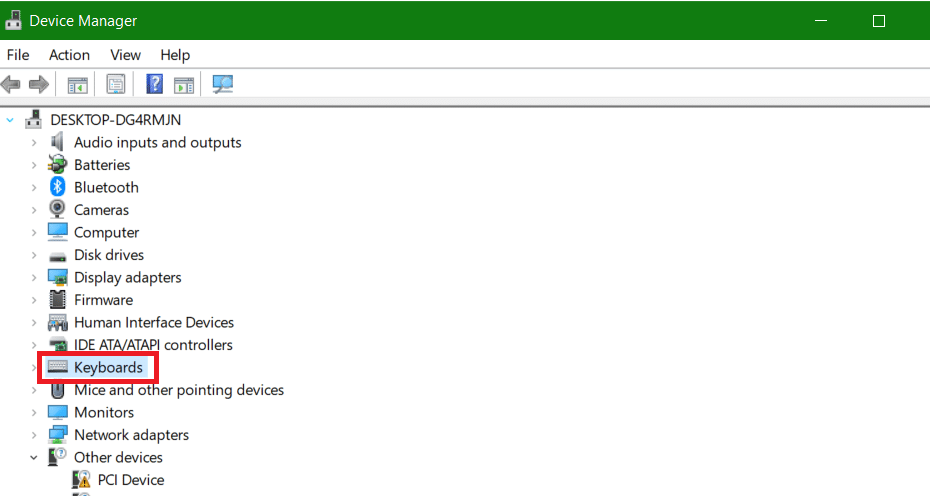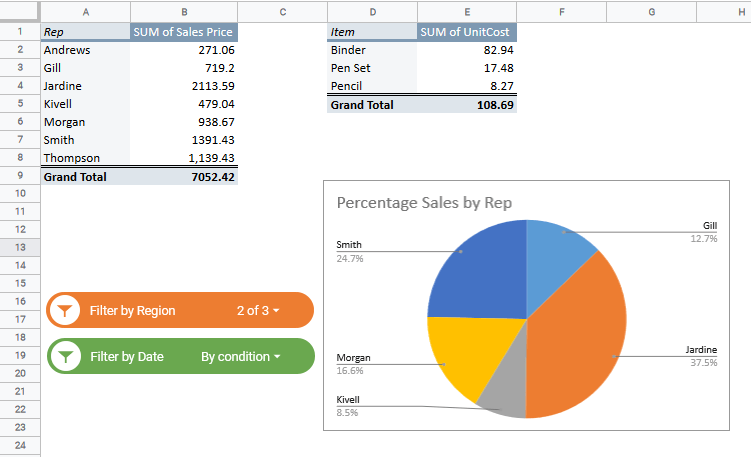Opening up your task manager and seeing 100% Disk Usage in Windows 10 can be horrible. Not only is it currently slowing your computer down, but it could also be causing damage by jostling the spinning components of a disk drive.
If left unchecked for long periods, this issue can also create too much heat for other components to deal with and slow your whole system down.
This Article Covers:
What Is Disk Usage and How Do You Know High Disk Usage Is Slowing Down Your PC?
A disk at 100% in Windows 10 error means that your hard drive is running at 100% capacity, which means it’s spinning at its highest rate all the time. Unfortunately, the cause is difficult to pin down. But you can follow these steps to help figure out the cause and then pick the best solution from our suggestions.
To identify high disk usage, Windows 10 can show data in the task manager. This can help to pinpoint if the high disk usage is slowing down your PC. Check with the following steps:
- Press ctrl+shift+esc on your keyboard to open the task manager
- Click on the “Disk” column so the little arrow is pointing down. The task manager will list the processes running on the disk in order of largest to most negligible impact.
- Any dark orange boxes mean the usage is high. Note which processes are putting increased demand on your disk. (You can see Chrome is putting high demand on the Memory in the example.)
How To Identify the Cause of 100% Disk Usage in Windows 10
A lot of the time, it’s hard to pinpoint the cause. But a good rule of thumb is that processes that demand over 1MB/s are not good. It is typical for short bursts of 100% disk usage, but consistent levels of even over 20% can damage your PC or disk drive. Use the method above to check in your task manager to see if any particular program is causing the issue and simply disable it, uninstall it, or reinstall it.
How To Fix 100% Disk Usage In Windows 10
So how do you fix this issue? There are many reasons why your hard drive can be running at 100%, and unfortunately, one solution doesn’t cover all the potential causes. We have assembled some of the most common solutions to the issue so you can quickly reference each and check which solution will work for you.
Because of the high disk usage, Windows 10 may run slower than usual, so you may have to be patient with some of these potential fixes.
Read on to find your fix for the 100% disk usage error.
Solution 1: The Classic Fix-All, A System Reboot
“Why is my disk at 100%, and how do I fix it?” could be answered with another question.
“Have you tried turning it off and on again?”
That question has become a classic turn of phrase since the integration of computers into our daily lives.
It works for many different issues with laptops and desktops, including the 100 percent disk usage error in Windows 10. Sometimes a program can get stuck loading on startup, and a reset will fix that.
The issue may come up again, or it may go away forever just from this simple fix.
Make sure you use “Restart” instead of “Shut down” when you’re performing this task. The restart will be more likely to return to a fresh state, and using shut down may cause the program that was causing the issue to come back on straight away.
Solution 2: Make Sure Windows Is Up To Date
Another classic first-response solution for an IT issue is ensuring the operating system is up to date.
Microsoft releases these updates to improve functionality and safety within the Windows environment. So, the issue you’re currently experiencing may be one of those fixed with the latest patch.
To check whether your system is up to date, go to “Start” > “Settings” > “Update & security” > “Windows update.”

After updating, you may also see other boosts to your computer’s performance.
Solution 3: Check for Viruses and Malware
If you have any software issues that transition into hardware faults, then a malware attack is a likely cause.
Even if you have a quality antivirus program running defense on your computer, it can sometimes miss things. Nothing is perfect, after all.
Run a system scan to help eliminate malware on the disk from the list of potential error causes.
A virus check may take an extremely long time as your disk is already running slowly. But it may also identify the issue. Be prepared to start the process and walk away from your computer for a few hours.
Solution 4: Complete a Cleanup of Junk Files
Junk files are single-use files that accumulate over time on your computer after completing tasks like viewing an image or browsing the web. They can cause performance issues, including high disk usage and a general slowing of your PC.
These files are unavoidable as your system needs to create them to perform certain functions. Still, if you regularly delete them, it should free up disk space and hopefully reduce 100% disk usage down to an acceptable level.
Some antivirus programs do this as part of their regular maintenance, so you can probably skip this method if you have a premium account on Avast, AVG, etc.
Luckily, Windows 10 has a built-in disk cleaner that does a great job of this in these few easy steps:
- Type disk cleanup into the search box of your taskbar and click on the app
- Choose the drive that is causing the issue and press “OK.”
- When given the option for files to delete, select “Downloaded Program Files” and “Temporary Internet Files,” then click “OK.”
Solution 5: Boost the Power Settings
A strange but straightforward potential way to reduce 100% disk usage to a reasonable level is to change the power settings from Balanced to High Performance.
To do this, all you have to do is:
- Open up “Control Panel.”
- Navigate to “System and Security“ > “Power Options“ > “Change plan settings“ > “Change advanced power settings.”
- Select “High performance” and click “Restore plan defaults.”

Solution 6: Disable Windows Search
Sometimes the search function of Windows 10 can cause a loop that ends up being brutal on your disk usage.
You can temporarily turn off Windows Search to see if it’s the issue and then turn it off permanently if you find it to be the cause.
To temporarily stop the Windows Search process, follow these steps:
- Search the command prompt by typing cmd in the search box.
- Right-click the app and click “Run as administrator” or select it from the right side of the taskbar.
3. Type net.exe stop “Windows Search” and press “Enter.”
If you find that Windows Search was causing the 100% disk usage issue, you can disable it permanently by using the following process:
- Press the Windows key + r to open the run dialog box.
- Type in “services.msc” and press “Enter.”
- Double-click on the Windows Search entry.
- Under “Startup type,” change the field to “Disabled.”
- Click “Apply” or “OK” to save the changes.
Solution 7: Disable Windows Superfetch – What Is Superfetch, and Should I Disable It?
Superfetch’s normal function is to reduce boot time by helping programs load more efficiently. However, it can cause a high disk usage error for your Windows 10 device if it malfunctions.
You can temporarily and permanently stop Superfetch with the same process used to disable Windows Search. Just type or find “Superfetch” instead of “Windows Search.”
Solution 8: Turn Off Your Antivirus Software
Although antivirus programs are designed to prevent issues arising on your computer, they can sometimes be the cause of them.
Most antivirus programs are simple to turn off from within their menus. If you see that the disk usage error is fixed after doing so, it may be time to switch the program you use.
Solution 9: Check for Physical Errors
Sometimes it’s not software causing the hardware issue, and maybe you dropped or bumped your laptop, or perhaps it’s just old. In either case, a damaged disk can cause a 100% usage error.
You can use Windows to check the physical health of a disk by using DSKCHK. All you have to do to check a disk is:
- Navigate to “This PC.”
- Right-click on the hard drive causing the problem.
- Click “Properties.”
- Then click “Tools” and “Check.”
The system will then check your hard drive for you. Sometimes it can take a while, but at least you can rule out physical issues without opening up your computer.
Solution 10: How To Fix 100 Disk Usage by Conducting a Virtual Memory Reset
Windows 10 sometimes uses the storage on your disk as though it were RAM to swap out temporary files when your physical ram is running low.
When your system does this, it creates a “pagefile.sys” file that can cause the 100% disk usage error when corrupted. To fix this error, you can reset the virtual memory. To do so, use these steps:
- Type “advanced system settings” into the search box on your taskbar.
- Click and open “View advanced system settings.”
- In the “Advanced” tab, click on “Settings” under the “Performance” heading.
- Click the “Advanced” tab, then “Change.”
- Uncheck the box that says “Automatically manage paging file size.”
- Check the “No paging file” marker.
- Press “OK,” then “Reboot” your computer.
Solution 11: Turn off Extensions in Your Browser (Change settings in Chrome)
It’s well-known that Google Chrome and its extensions can chew up your RAM. But did you know it can sometimes cause issues with your hard disk too?
Turning off any Chrome extensions that have access to your hard drive can sometimes be the answer to your 100% disk usage woes. Or you could even use a different browser.
To turn off extensions in Chrome:
- Click the puzzle button in the top right corner of Chrome.
- Click manage extensions.
- Turn the toggle button off.
Solution 12: How To Reduce Disk Usage by Uninstalling Adobe Flash Player
Since the 90s, Flash Player by Adobe has been one of the most used web applications. It was responsible for animation, interactivity, audio, and video. But they stopped updating the software in late 2020, which made it redundant in all but a few cases.
Windows 10 has Flash Player preinstalled on it, but since Adobe no longer supports the software, they recommend uninstalling it. So, even if you found a different solution to your disk issue, you could still perform this process:
- Click this link to the Adobe Flash Uninstaller and download it.
- Run the software.
- Click “Uninstall.”
- Restart your computer.
Solution 13: How to Lower Disk Usage by Restarting Your Computer With a Clean Boot
When you initiate a clean boot, Windows 10 will restart with fewer startup programs and drivers. Then you can selectively reinstall third-party programs one at a time to identify which program is causing the disk problem.
This option is one of the best to allow you to single out a cause. But, it can also take a long time to reinstall each program one by one and wait a while to see if they were the cause of the disk error.
The following steps will show you how to restart with a clean boot:
- Type “MSConfig” into the search box in your taskbar.
- Open “System Configuration.”
- Under the “General” tab, check the selective startup option.
- Check “Load system services.”
- Uncheck “Load startup items.”
- Keep “Use original boot configuration” checked.
- Click the “Services” tab.
- Check the “Hide all Microsoft services” box.
- Click “Disable all.”
- Click “Apply” or “OK.”
- “Reboot” your computer.
- Optional: Follow steps 1-9, then check one program at a time to add back in and reboot to see if it’s the one causing the 100% disk error.
Solution 14: Upgrade Your Hardware – Will an SSD Solve 100 Disk Usage?
It’s possible that, even after a disk check, the drive itself is still to blame for the Windows 10 100% disk usage issue. Hard Disk Drives (HDD) have a limited lifespan as the spinning parts wear away with friction over time.
So, it may be time to replace the disk to prevent more high disk usage in Windows 10.
If you’re using an old spinning disk drive, you’ll thank yourself for the upgraded speeds by switching to a Solid State Drive (SSD). These drives are much faster and more reliable than traditional HDDs, and many manufacturers make models designed to fit into older computers.
Since they’re not a new technology anymore, SSDs don’t cost that much more than an HDD, so if you need to replace the disk anyway, you might as well splash out on an SSD.
Warning: Don’t Try These Methods
While there are a lot of potential functional fixes for the Windows 10 100% disk error, there are also some that could work in the short term but risk causing more damage to your PC over time.
Disabling Windows Updates
It is very easy to see instances of planned obsolescence in the tech world, and software updates can sometimes be the catalyst for this. It’s still a bad idea to disable Windows updates.
As we mentioned earlier, updates to Windows 10 have solved the 100% disk usage error in the past.
Indeed, operating system updates can sometimes come with their own issues, but it’s in the software companies’ best interest to fix those problems as soon as possible.
Disabling BITS
BITS is another update service for Windows 10 that creates new system parameters to coincide with Windows updates. Turning this service off could result in mismatched software patches, which will cause further problems for your PC.
Manually Modifying Page Files
While we recommended rebooting your “pagefile.sys” in the virtual memory reset solution (solution 10), manually editing the file with custom values could further damage your disk.
It’s best to let Windows manage your virtual memory when possible so as not to cause any long-term issues.
Frequently Asked Questions
Why Is 100% Of My Disk Being Used All the Time? / How Do I Fix 100% Disk Usage in Windows 10?
Unfortunately, there’s not just one cause for the 100% disc usage error. You’ll need to experiment with the solutions in this guide to discover what’s causing it and how to fix it.
How Do I Fix Disk 100% In Task Manager?
If you want to fix the task manager’s 100% disk error and you can see the program that is causing it, you can simply right-click it and select “end task.”
How Much Disk Usage Is Normal?
It is normal for short bursts to reach 100%, but anything that is sustained for long periods of 20% is not normal.
Can Running Windows 10 at 100% Disk Usage Damage My Disk?
Yes, if the disk is running at 100%, the excessive friction can cause wear on it, shortening its lifespan. The heat generated may also be bad for other components in your PC.
Which Solution to the 100% Disk Error in Windows 10 Should I Use?
As the root cause of the 100% Disk Usage in Windows 10 problem is hard to nail down, it’s impossible to say which solution could be the most appropriate. Although the order in which you could test the solutions out could be:
- Complete a hard restart of your computer.
- Check Windows is up to date.
- Check for any viruses and malware.
- Check for physical faults with the drive.
From there, it’s kind of an educated guess-type affair. You’ll have to think of the potential cause and pick a solution from the list that you think will be most effective.
Hopefully, one of the first methods for fixing the issue will work. You could even just consider upgrading your components as the first option if your budget allows for it. The improved speeds offered by a solid-state drive are worth their cost anyway.
Once your computer is back online, its productivity will increase 100-fold. Check out some of our other articles so your personal productivity can accelerate to match, like using Google Calendar.
Related:
- How To Find a Windows 10 Product Key [6 Easy Ways]
- How To Use a Windows Keyboard on a Mac (Guide)
- How To Rotate a Screen in Windows 10 [3 Easy Ways]


























